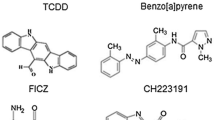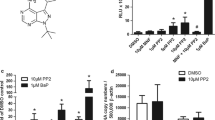Abstract
The aryl hydrocarbon receptor (AhR) ligand activities of six known AhR ligands were compared in vivo and in vitro. The in vivo ligand activity was estimated in terms of induction of cytochrome P450 1A1/2 activities, i.e., ethoxyresorufin-O-dealkylase (EROD) and methoxyresorufin-O-dealkylase (MROD) activities, and in vitro ligand activity was evaluated with a recombinant yeast reporter gene assay. The test chemicals were 3-methylcholanthrene (MC), β-naphthoflavone (β-NF), indirubin, indigo, 3,3′-diindolylmethane (DIM) and diphenyl-p-phenylenediamine (DPPD). The first four showed potent AhR ligand activity in vitro, comparable with that of 2,3,7,8-tetrachlorodibenzo-p-dioxin, while DIM and DPPD showed weaker activity. Administration of MC and β-NF to mice caused significant induction of EROD and MROD activities, while indirubin, indigo and DIM also induced these activities, but less potently. DPPD also induced the activities, but was toxic at higher doses. These enhancing effects were lost or greatly reduced in Ahr-null mice (Ahr −/−). Our results suggest that EROD and MROD activity assays are useful for evaluating the AhR ligand activity of chemicals in vivo, where the biodynamics of the chemicals plays an important role.




Similar content being viewed by others
References
Abraham K, Geusau A, Tosun Y, Helge H, Bauer S, Brockmoller J (2002) Severe 2,3,7,8-tetrachlorodibenzo-p-dioxin (TCDD) intoxication: insights into the measurement of hepatic cytochrome P450 1A2 induction. Clin Pharmacol Therap 72:163–174
Adachi J, Mori Y, Matsui S, Takigami H, Fujino J, Kitagawa H, Miller CA III, Matsuda T (2001) Indirubin and indigo are potent aryl hydrocarbon receptor ligands present in human urine. J Biol Chem 276:31475–31478
Behnisch PA, Hosoe K, Brouwer A, Sakai S (2002) Screening of dioxin-like toxicity equivalents for various matrices with wildtype and recombinant rat hepatoma H4IIE cells. Toxicol Sci 69:125–130
Birnbaum LS (1994) Evidence for the role of the Ah receptor in response to dioxin. In: Spitzer HL, Slaga TJ, Greenlee WF, McClain M (eds) Progress in clinical and biological research, vol 387. Wiley-Liss, New York, pp 139–154
Burke MD, Thompson S, Elcombe CR, Helpert J, Haaparanta T, Mayer RT (1985) Ethoxy-, pentoxy- and benzyloxyphenoxazones and homologues: a series of substrates to distinguish between different induced cytochromes P-450. Biochem Pharmacol 34:3337–3345
Burke MD, Thompson S, Weaver RJ, Wolf CR, Mayer RT (1994) Cytochrome P450 specificities of alkoxyresorufin O-dealkylation in human and rat liver. Biochem Pharmacol 48:923–936
Delescluse C, Lemaire G, de Sousa G, Rahmani R (2000) Is CYP1A1 induction always related to AHR signaling pathway? Toxicology 153:73–82
Denison MS, Heath-Pagliuso S (1998) The Ah receptor: a regulator of the biochemical and toxicological actions of structurally diverse chemicals. Bull Environ Contam Toxicol 61:557–568
Diliberto JJ, Burgin D, Birnbaum LS (1997) Role of CYP1A2 in hepatic sequestration of dioxin: studies using CYP1A2 knock-out mice. Biochem Biophys Res Commun 236:431–433
Fernandez-Salgureo PM, Hilbert DM, Rudikoff S, Ward JM, Gonzales FJ (1996) Aryl-hydrocarbon receptor-deficient mice are resistant to 2,3,7,8-tetrachlorodibenzo-p-dioxin-induced toxicity. Toxicol Appl Pharmacol 140:173–179
Hoessel R, Leclerc S, Endicott JA, Nobel MEM, Lawrie A, Tunnah P, Leost M, Damiens E, Marie D, Niederberger E, Tang W, Eisenbrand G, Meijer L (1999) Indirubin, the active constituent of a Chinese antileukaemia medicine, inhibits cyclin-dependent kinases. Nat Cell Biol 1:60–168
Huff J, Lucier G, Tritscher A (1994) Carcinogenicity of TCDD: experimental, mechanistic, and epidemiologic evidence. Annu Rev Pharmacol Toxicol 35:343–372
Kociba RJ, Schwetz BA (1982) Toxicity of 2,3,7,8-tetrachlorodibenzo-p-dioxin (TCDD). Drug Metab Rev 13:387–406
Ledirac N, Delescluse C, De Sousa G, Pralavorio M, Lesca P, Amichot M, Berge JB, Rahmani RS (1997) Carbaryl induces CYP1A1 gene expression in HepG2 and HaCaT cells but is not a ligand of the human hepatic Ah receptor. Toxicol Appl Pharmacol 144:177–182
Lowry OH, Rosebrough NJ, Farr AL, Randall RJ (1955) Protein measurement with the Folin phenol reagent. J Biol Chem 193:265–275
Miller CA (1997) Expression of the human aryl hydrocarbon receptor complex in yeast. Activation of transcription by indole compounds. J Biol Chem 272:32824–32829
Miller CA (1999) A human aryl hydrocarbon receptor signaling pathway constructed in yeast displays additive responses to ligand mixtures. Toxicol Appl Pharmacol 160:297–303
Mimura J, Fujii-Kuriyama Y (2003) Functional role of AhR in the expression of toxic effects by TCDD. Biochim Biophys Acta 1619:263–268
Mimura J, Yamashita K, Nakamura K, Morita M, Takagi TN, Nakao K. Ema M, Sogawa K, Yasuda M, Katsuki M, Fuji-Kuriyama Y (1997) Loss of teratogenic response to 2,3,7,8-tetrachlorodibenzo-p-dioxin (TCDD) in mice lacking the Ah (dioxin) receptor. Genes Cells 2:645–654
Murk AJ, Legler J, Denison MS, Giesy JP, van de Guchte C, Brouwer A (1996) Chemical-activated luciferase gene expression (CALUX): a novel in vitro bioassay for Ah receptor active compounds in sediments and pore water. Fundam App Toxicol 33:149–160
Poland A, Knutson JC (1982) 2,3,7,8-Tetrachlorodibenzo-p-dioxin and related halogenated aromatic hydrocarbons: examination of the mechanism of toxicity. Annu Rev Pharmacol Toxicol 22:517–524
Prough RA, Burke MD, Mayer RT (1978) Direct fluorometric methods for measuring mixed-function oxidase activity. Methods Enzymol 52(Biomembranes, Part C):372–377
Seree E, Villard PH, Pascussi JM, Pineau T, Maurel P, Nguyen QB, Fallone F, Martin PM, Champion S, Lacarelle B, Savouret J, Barra Y (2004) Evidence for a new human CYP1A1 regulation pathway involving PPAR-α and 2 PPRE sites. Gastroenterology 127:1436–1445
Shimizu Y, Nakatsuru Y, Ichinose M, Takahashi Y, Kume H, Mimura J, Fujii-Kuriyama Y, Ishikawa T (2000) Benzo[a]pyrene carcinogenicity is lost in mice lacking the aryl hydrocarbon receptor. Proc Nati Acad Sci USA 97:779–782
Stohs SJ (1990) Med Oxidative stress induced by 2,3,7,8-tetrachlorodibenzo-p-dioxin (TCDD). Free Radical Biol 9:79–90
Sugihara K, Kitamura S, Yamada T, Ohta S, Yamashita K, Yasuda M, Fujii-Kuriyama Y (2001) Aryl hydrocarbon receptor (AhR)-mediated induction of xanthine oxidase/xanthine dehydrogenase activity by 2,3,7,8-tetrachlorodibenzo-p-dioxin. Biochem Biophys Res Commun 281:1093–1099
Sugihara K, Kitamura S, Yamada T, Okayama T, Ohta S, Yamashita K, Yasuda M, Fujii-Kuriyama Y, Saeki K, Matsui S, Matsuda T (2004) Aryl hydrocarbon receptor-mediated induction of microsomal drug-metabolizing enzyme activity by indirubin and indigo. Biochem Biophys Res Commun 318:571–578
Toyoshiba H, Walker NJ, Bailer AJ, Portier CJ (2004) Evaluation of toxic equivalency factors for induction of cytochromes P450 CYP1A1 and CYP1A2 enzyme activity by dioxin-like compounds. Toxicol Appl Pharmacol 194:156–168
Queval P, Beaumatin J, Morin M, Courtois D, Lafuma J (1979) Inducibility of microsomal enzymes in normal and pre-cancerous lung tissue. Synergistic action of 5,6-benzoflavon or methylcholanthrene in radiation induced carcinogenesis. Biomedicine 31:182–186
Wilson CL, Safe S (1998) Mechanisms of ligand-induced aryl hydrocarbon receptor-mediated biochemical and toxic responses. Toxicol Pathol 26:657–671
Wu M, Li H, Wu D, Wang X, Chen X, Kong Q, Ma J, Gao Y, Liu J (2005) CYP1A1 and CYP1B1 expressions in medulloblastoma cells are AhR-independent and have no direct link with resveratrol-induced differentiation and apoptosis. Neurosci Lett 384:33–37
Acknowledgments
This study was financially supported by Ministry of Economy, Trade and Industry, Japan. We thank Prof. Y. Fujii-Kuriyama, Tsukuba University, Japan, who provided Ahr −/− mice, and Prof. Charles A. Miller III, Tulane University School of Public Health and Tropical Medicine, Louisiana, who provided the recombinant yeast for AhR ligand activity assay.
Author information
Authors and Affiliations
Corresponding author
Rights and permissions
About this article
Cite this article
Sugihara, K., Okayama, T., Kitamura, S. et al. Comparative study of aryl hydrocarbon receptor ligand activities of six chemicals in vitro and in vivo. Arch Toxicol 82, 5–11 (2008). https://doi.org/10.1007/s00204-007-0232-3
Received:
Accepted:
Published:
Issue Date:
DOI: https://doi.org/10.1007/s00204-007-0232-3




